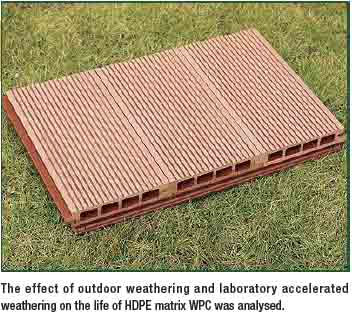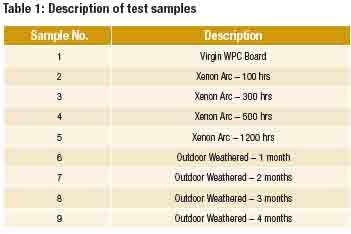
A study was conducted to determine the predicted service life (PSL) of a Korean manufactured wood plastic composite (WPC). The reliability and PSL are determined based on the effects of accelerated, laboratory weathering using xenon arc exposure and outdoor weathering on a HDPE matrix wood-polymer composite deck board. Extensive chemical analysis was performed to identify the method of material degradation and failure. Antioxidant levels and oxidation index times were measured and are compared using statistical software to determine the PSL based on the effects of both weathering environments. Samples were weathered and physical testing was done in South Korea by the Korea Institute of Construction Materials (KICM). Chemical analysis testing and test result analysis were conducted in the United States by Aspen Research (Aspen) in White Bear Lake, MN. The research was funded by Standardization Research for Construction Materials (SCM) and KICM under the Construction Technology Infrastructure Project. The project's objective was to investigate the effect of outdoor weathering and laboratory accelerated weathering on the PSL of HDPE matrix WPC. Samples are weathered and tested by KICM and the resulting data is analysed by Aspen using advanced service life prediction software. The Korean WPC product supplied to Aspen by KICM was identified as a blend of wood filler, high density polyethylene (HDPE), pigment, and anti-weathering additives. Some of the samples had been exposed to filtered ultraviolet radiation, heat and moisture in xenon arc chambers (Ci4000 Weather-Ometer®manufactured by Atlas MTT) and some had been exposed at the KICM outdoor weathering facility.
Documentation of WPC Samples The objective is to define the reliability, in terms of PSL in South Korea, of the supplied HDPE matrix WPC deck board, while the system is defined as the Korean manufactured WPC profile to be used in South Korea as a deck board. The samples used in this project were conditioned before testing as described in Table 1. The test samples were extruded from WPC which has the approximate formulation shown in Table 2.

Chemical extraction and pyrolysis were used to isolate additives in the WPC samples. Samples for extraction were taken from: the outer 1 mm layer of the surface material that had been exposed to UV, the interior of samples weathered 1200 hrs in the xenon arc chamber, and from the interior of the control samples. The samples were extracted using heated cyclohexane. HPLC-mass spectrometry was used to determine the organic compounds contained in the solvent extract solutions. The retention times and peaks of the mass spectra were consistent with Irganox 1010, (antioxidant A) and the phosphite and phosphate forms of Irgafos 168, (antioxidant B). Samples were pyrolized for 3 hours at 500C. The remains (ashes and other solids) were tested by FTIR. The primary content of the ash was calcium carbonate and talc. The ash residue was 10% of the formulation. The extraction data in Table 3 indicates that the total antioxidant level was relatively low in all of the samples. Relative to the control surface and interior samples, the data also shows that antioxidant A is nearly depleted in the surface layers of samples from both types of conditioning. A significant fraction of the initial amount of antioxidant B was retained in all the weathered samples. The majority of antioxidant B was seen as its phosphate rather than phosphite form. FTIR was used to measure oxidation and other chemical changes in the UV additives and other organic compounds in the composite. FTIR with ATR (Attenuated Total Reflectance) was used to detect the surface compounds using a Mattson Galaxy 5000 FT-IR with a Pike Miracle ATR (ZnSe crystal) accessory. Specimens were taken from the interior and the weathered surface of each
Air Force 1 Low Upstep BR A study was conducted to determine the predicted service life (PSL) of a Korean manufactured wood plastic composite (WPC). The reliability and PSL are determined based on the effects of accelerated, laboratory weathering using xenon arc exposure and outdoor weathering on a HDPE matrix wood-polymer composite deck board. Extensive chemical analysis was performed to identify the method of material degradation and failure. Antioxidant levels and oxidation index times were measured and are compared using statistical software to determine the PSL based on the effects of both weathering environments. Samples were weathered and physical testing was done in South Korea by the Korea Institute of Construction Materials (KICM). Chemical analysis testing and test result analysis were conducted in the United States by Aspen Research (Aspen) in White Bear Lake, MN. The research was funded by Standardization Research for Construction Materials (SCM) and KICM under the Construction Technology Infrastructure Project. The project's objective was to investigate the effect of outdoor weathering and laboratory accelerated weathering on the PSL of HDPE matrix WPC. Samples are weathered and tested by KICM and the resulting data is analysed by Aspen using advanced service life prediction software. The Korean WPC product supplied to Aspen by KICM was identified as a blend of wood filler, high density polyethylene (HDPE), pigment, and anti-weathering additives. Some of the samples had been exposed to filtered ultraviolet radiation, heat and moisture in xenon arc chambers (Ci4000 Weather-Ometer®manufactured by Atlas MTT) and some had been exposed at the KICM outdoor weathering facility. Documentation of WPC Samples The objective is to define the reliability, in terms of PSL in South Korea, of the supplied HDPE matrix WPC deck board, while the system is defined as the Korean manufactured WPC profile to be used in South Korea as a deck board. The samples used in this project were conditioned before testing as described in Table 1. The test samples were extruded from WPC which has the approximate formulation shown in Table 2.
A study was conducted to determine the predicted service life (PSL) of a Korean manufactured wood plastic composite (WPC). The reliability and PSL are determined based on the effects of accelerated, laboratory weathering using xenon arc exposure and outdoor weathering on a HDPE matrix wood-polymer composite deck board. Extensive chemical analysis was performed to identify the method of material degradation and failure. Antioxidant levels and oxidation index times were measured and are compared using statistical software to determine the PSL based on the effects of both weathering environments. Samples were weathered and physical testing was done in South Korea by the Korea Institute of Construction Materials (KICM). Chemical analysis testing and test result analysis were conducted in the United States by Aspen Research (Aspen) in White Bear Lake, MN. The research was funded by Standardization Research for Construction Materials (SCM) and KICM under the Construction Technology Infrastructure Project. The project's objective was to investigate the effect of outdoor weathering and laboratory accelerated weathering on the PSL of HDPE matrix WPC. Samples are weathered and tested by KICM and the resulting data is analysed by Aspen using advanced service life prediction software. The Korean WPC product supplied to Aspen by KICM was identified as a blend of wood filler, high density polyethylene (HDPE), pigment, and anti-weathering additives. Some of the samples had been exposed to filtered ultraviolet radiation, heat and moisture in xenon arc chambers (Ci4000 Weather-Ometer®manufactured by Atlas MTT) and some had been exposed at the KICM outdoor weathering facility. Documentation of WPC Samples The objective is to define the reliability, in terms of PSL in South Korea, of the supplied HDPE matrix WPC deck board, while the system is defined as the Korean manufactured WPC profile to be used in South Korea as a deck board. The samples used in this project were conditioned before testing as described in Table 1. The test samples were extruded from WPC which has the approximate formulation shown in Table 2.  Chemical extraction and pyrolysis were used to isolate additives in the WPC samples. Samples for extraction were taken from: the outer 1 mm layer of the surface material that had been exposed to UV, the interior of samples weathered 1200 hrs in the xenon arc chamber, and from the interior of the control samples. The samples were extracted using heated cyclohexane. HPLC-mass spectrometry was used to determine the organic compounds contained in the solvent extract solutions. The retention times and peaks of the mass spectra were consistent with Irganox 1010, (antioxidant A) and the phosphite and phosphate forms of Irgafos 168, (antioxidant B). Samples were pyrolized for 3 hours at 500C. The remains (ashes and other solids) were tested by FTIR. The primary content of the ash was calcium carbonate and talc. The ash residue was 10% of the formulation. The extraction data in Table 3 indicates that the total antioxidant level was relatively low in all of the samples. Relative to the control surface and interior samples, the data also shows that antioxidant A is nearly depleted in the surface layers of samples from both types of conditioning. A significant fraction of the initial amount of antioxidant B was retained in all the weathered samples. The majority of antioxidant B was seen as its phosphate rather than phosphite form. FTIR was used to measure oxidation and other chemical changes in the UV additives and other organic compounds in the composite. FTIR with ATR (Attenuated Total Reflectance) was used to detect the surface compounds using a Mattson Galaxy 5000 FT-IR with a Pike Miracle ATR (ZnSe crystal) accessory. Specimens were taken from the interior and the weathered surface of eachAir Force 1 Low Upstep BR
Chemical extraction and pyrolysis were used to isolate additives in the WPC samples. Samples for extraction were taken from: the outer 1 mm layer of the surface material that had been exposed to UV, the interior of samples weathered 1200 hrs in the xenon arc chamber, and from the interior of the control samples. The samples were extracted using heated cyclohexane. HPLC-mass spectrometry was used to determine the organic compounds contained in the solvent extract solutions. The retention times and peaks of the mass spectra were consistent with Irganox 1010, (antioxidant A) and the phosphite and phosphate forms of Irgafos 168, (antioxidant B). Samples were pyrolized for 3 hours at 500C. The remains (ashes and other solids) were tested by FTIR. The primary content of the ash was calcium carbonate and talc. The ash residue was 10% of the formulation. The extraction data in Table 3 indicates that the total antioxidant level was relatively low in all of the samples. Relative to the control surface and interior samples, the data also shows that antioxidant A is nearly depleted in the surface layers of samples from both types of conditioning. A significant fraction of the initial amount of antioxidant B was retained in all the weathered samples. The majority of antioxidant B was seen as its phosphate rather than phosphite form. FTIR was used to measure oxidation and other chemical changes in the UV additives and other organic compounds in the composite. FTIR with ATR (Attenuated Total Reflectance) was used to detect the surface compounds using a Mattson Galaxy 5000 FT-IR with a Pike Miracle ATR (ZnSe crystal) accessory. Specimens were taken from the interior and the weathered surface of eachAir Force 1 Low Upstep BR













